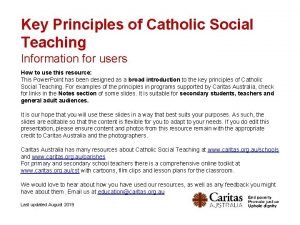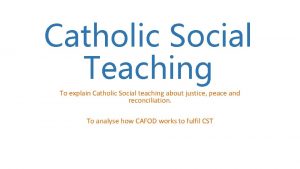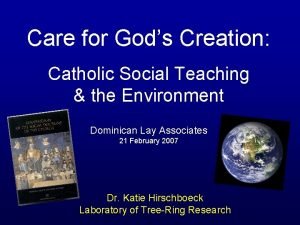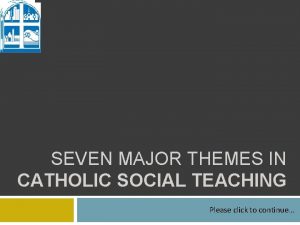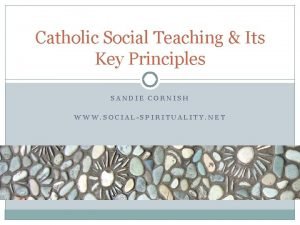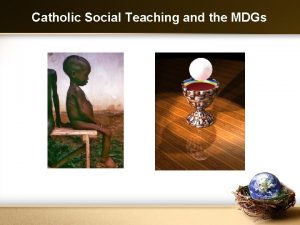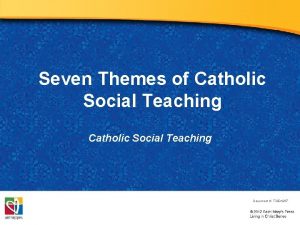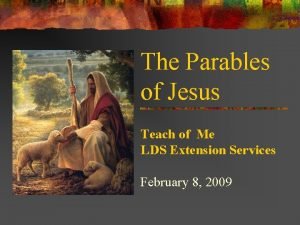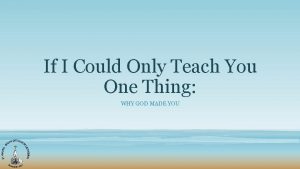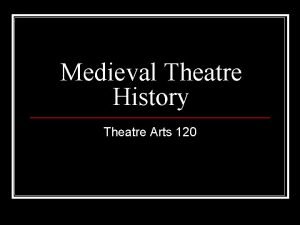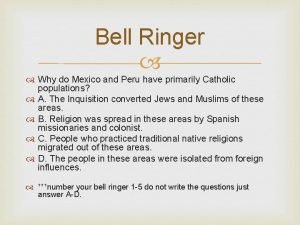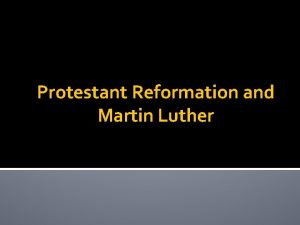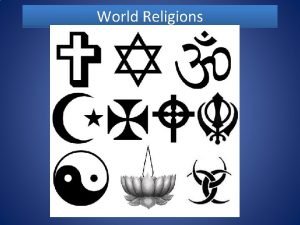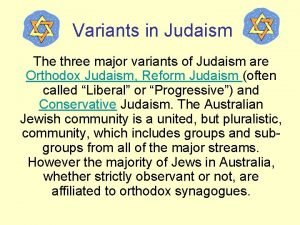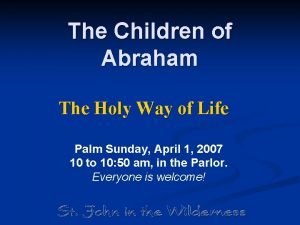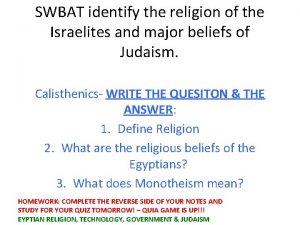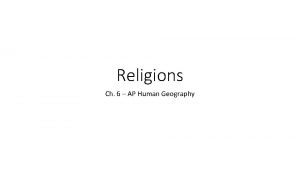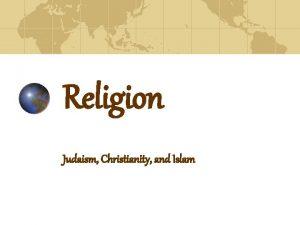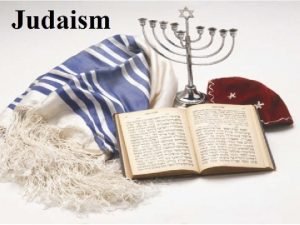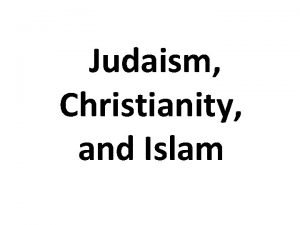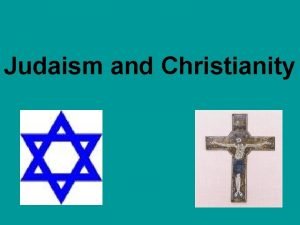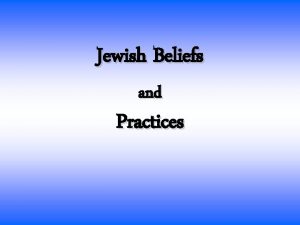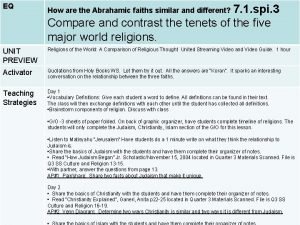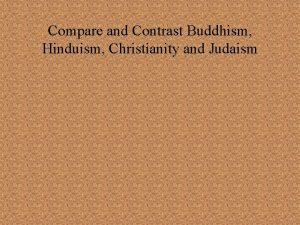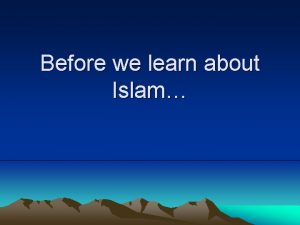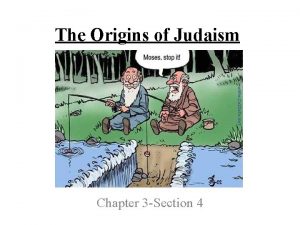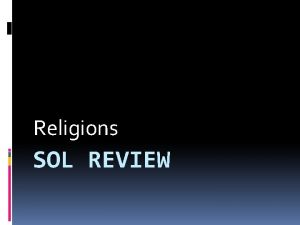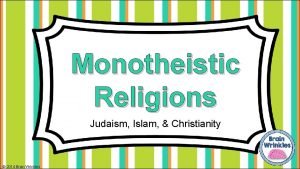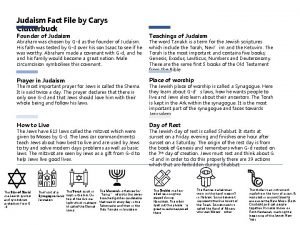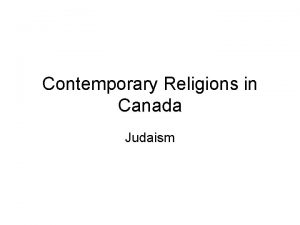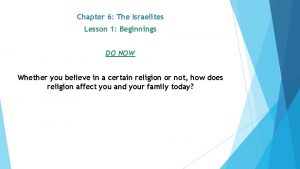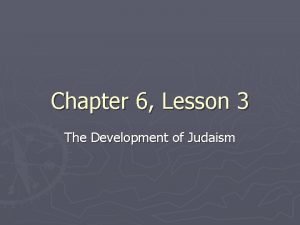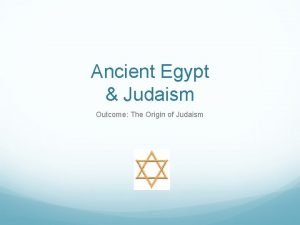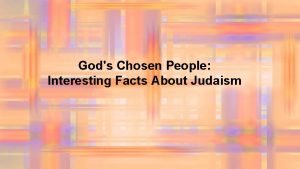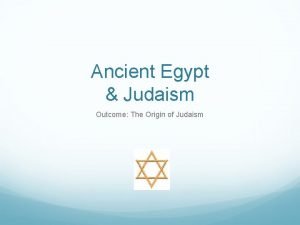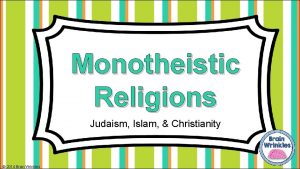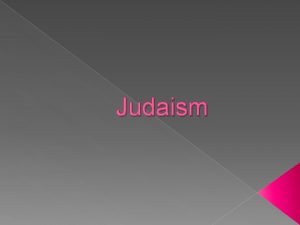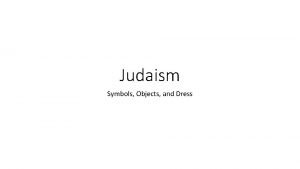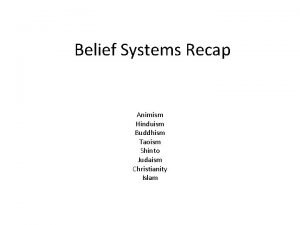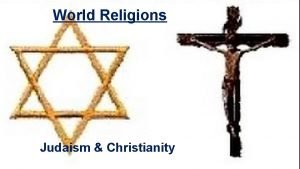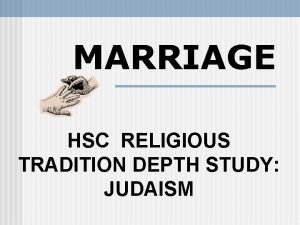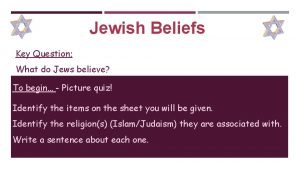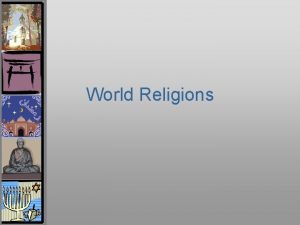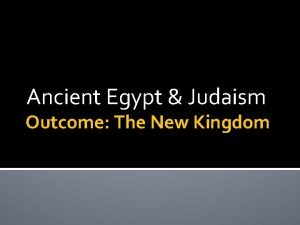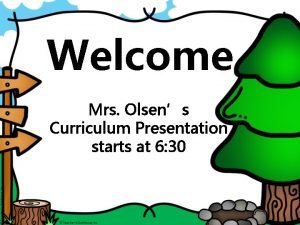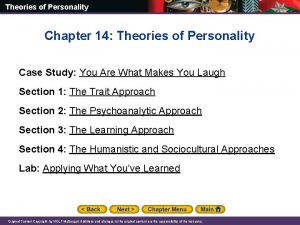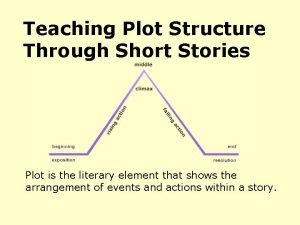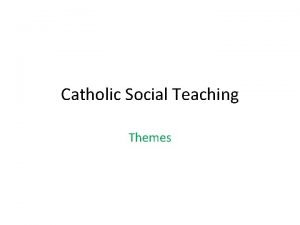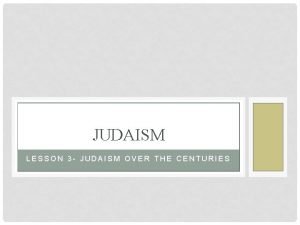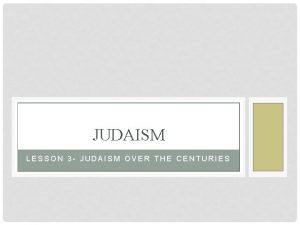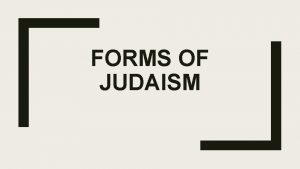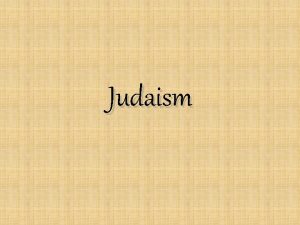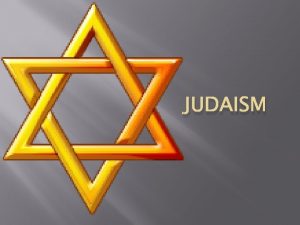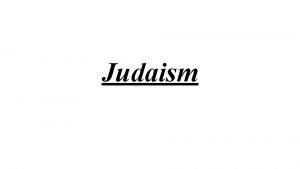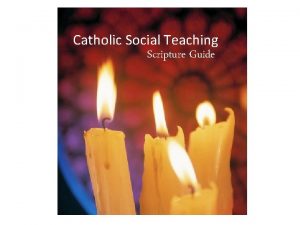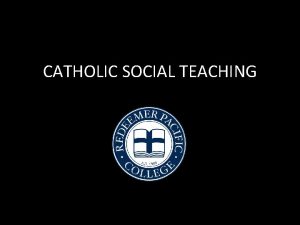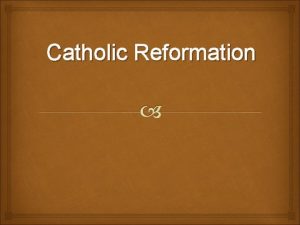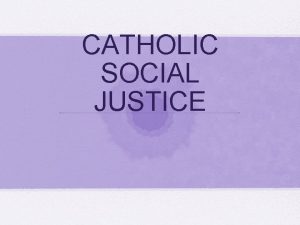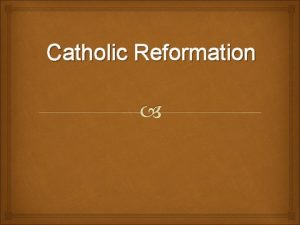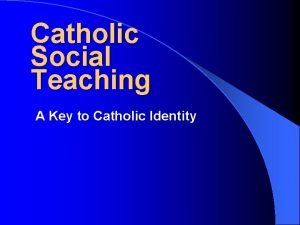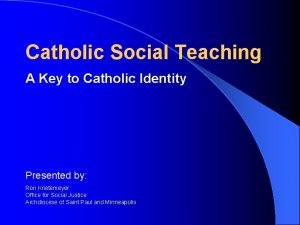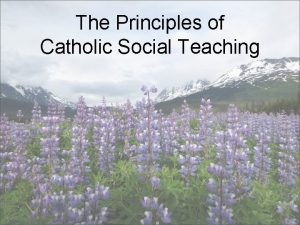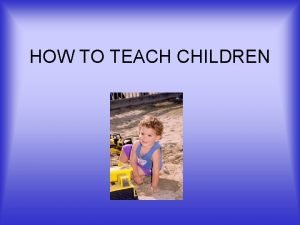Teaching Judaism Why teach Judaism in a Catholic




























































- Slides: 60

Teaching Judaism

Why teach Judaism in a Catholic school?

Melbourne declaration Goal 2: All young Australians become successful learners, confident and creative individuals, and active and informed citizens

Active and informed citizens… – act with moral and ethical integrity – appreciate Australia’s social, cultural, linguistic and religious diversity, and have an understanding of Australia’s system of government, history and culture –– are able to relate to and communicate across cultures, especially the cultures and countries of Asia –– are responsible global and local citizens

Preparing students to live in a multi-faith world

Nostra Aetate The Catholic Church’s relationship to non-Christian religions was formally expressed in the Second Vatican Council’s Declaration Nostra Aetate promulgated on 28 October, 1965. The document was originally intended to address the ‘Jewish question’ particularly Christianity’s historical relationship with Judaism and it was to have a particular focus on the Shoah (Holocaust)

The final document did not mention the Shoah, however it did include a small section on Islam and a brief mention of Buddhism, Hinduism. Nostra Aetate concentrates on the Catholic church’s relationship with Judaism and explicitly states that the church “…draws sustenance from the root of that wellcultivated olive tree onto which have been grafted the wild roots, the Gentiles” (NA 7)

“Today we need to teach about Judaism in a way that acknowledges God’s continuing and lasting Covenant with the Jews. Christians need to understand Judaism since Christian origins are inextricably bound up in Judaism. But we have to move beyond teaching about Jews as “Hebrews of old” (Boys, 2006, p. 10) and begin to teach about Judaism as a living religion and to teach about Jews as they define themselves not as we define them. ” (Dr Peta Goldburg, Religious Educators leading understanding in a multi-faith Australia)

What do we know about the Jewish religion?

3 questions

Groups within Judaism There are three main groups within Judaism; Reform Judaism, Orthodox Judaism, and Conservative Judaism. Orthodox Jews practice full observance of Jewish religious laws (halakhah). They believe that the law recorded in the Torah is a direct expression of G*d’s will and it is therefore unchanging. Orthodox Jews accept changes in the halakhah but they must be based on specific religious texts, codes and commentaries. The changes must also be recognised by the rabbinical authority.

The Haredim and Hasidic Jews are the most obvious of the two Orthodox groups as they preserve the traditional dress of their European ancestors – long black coats, hats and beards for males, and modest dresses for women.

Conservative Judaism Conservative Jews are more traditional than Reform Jews but less traditional than the Orthodox Jews. The belief in the ongoing authority of Jewish law is shared with Orthodox Jews, yet Conservative Jews stress the historical development of Judaism. They therefore believe that Jewish law can be changed. Conservative Judaism is the largest group within Judaism, particularly in America. It is very rare for Conservative Jews to inter-marry, and maintaining traditional Jewish practices is important.

Reform Judaism is also known as Progressive or Liberal Judaism. This group within Judaism emerged in the late 1700’s with the emancipation of the Jews. Reform Judaism is influenced by social, scientific, and ethical developments in modern society. This belief in change is also mirrored in the design of the Reform synagogues which, unlike Orthodox synagogues, do not separate men and women.

Core Beliefs

Judaism is one of the world’s oldest religions, dating back approximately four thousand years. The belief in one G*d, who is personal and intervenes in human history, sets Judaism apart from other religions of the ancient world. This concept is illustrated in the book of Exodus which tells the story of Moses leading the Hebrew people from slavery in Egypt to freedom in the promised land.

Jews are often referred to as a ‘covenant people’. The covenant was made between G*d and the Jews when they escaped from Egypt and received the Commandments through Moses on Mount Sinai. Jews believe that this covenant with G*d continues through time and history.

Covenant – Abraham and Sarah (Year 2 Religion Curriculum) Covenant Promise Land Change of name Number Descendants

Covenant – map of Israel

Covenant – Abraham and Sarah

Relationship with G*d The Jewish relationship with God is a covenant relationship, therefore Jews try to keep G*d's laws, as outlined in the Torah and Talmud, and bring holiness to every aspect of their lives. There are 613 mitzvot, or commandments, found in the Torah and Talmud which Jews can follow in order to bring holiness to their lives.

These laws include food and dietary laws which can take the form of keeping ‘kashrut’ or ‘kosher’ in Jewish households.

Shabbat Every week religious Jews observe the Sabbath and keep its laws and customs. The Sabbath begins at nightfall on Friday and lasts until nightfall on Saturday. The idea of a day of rest comes from the Bible story of the Creation in Genesis 1. God rested from creating the universe on the seventh day, so Jews rest from work on the Sabbath. God also commanded the Jews to observe the Sabbath and keep it holy as the fourth of the Ten Commandments. Jews often call the day Shabbat, Hebrew for Sabbath, which means ‘rest’. The Sabbath is a reminder of the Covenant that God made with the Israelites, and so it is an occasion to rejoice in God's kept promises.

In order to avoid work and to ensure that the Sabbath is special, all chores like shopping, cleaning, and cooking for the Sabbath must be finished before sunset on Friday. Sabbath candles are lit at sunset on a Friday. The woman of the house usually performs this ritual. It is an integral part of Jewish custom and ceremony. After the candles are lit, Jewish families will drink wine. Sabbath wine is sweet and is usually drunk from a special goblet known as the Kiddush Cup. The drinking of wine on the Sabbath symbolises joy and celebration. It is also traditional to eat challah, a soft bread in the shape of a braid. Under Jewish law, every Jew must eat three meals on the Sabbath. One of the meals must include bread. Observant Jews will usually eat challah at the beginning of a Sabbath meal. http: //www. youtube. com/watch? v=5 GW-fr. Pw 2 o. I&feature=related

Strictly Kosher - Shabbat

Shalom Sesame Shabbat Shalom, Grover!

Sacred Text

Torah The Torah is the first part of the Jewish bible. It is the central and most important document of Judaism. Torah refers to the five books of Moses which are Bresheit (Genesis), Shemot (Exodus), Vayicra (Leviticus), Bamidbar (Numbers), and Devarim (Deuteronomy). Jews believe that God dictated the Torah to Moses on Mount Sinai 50 days after their exodus from Egyptian slavery. They believe that the Torah shows how G*d wants Jews to live. The books contains 613 commandments and Jews refer to the ten best known of these as the ‘ten statements’.

The Torah is written in Hebrew, the oldest of Jewish languages. It is also known as Torat Moshe, the Law of Moses. However, Tanach is more commonly used to describe the whole of Jewish scriptures, including the Prophets and the writings.

Key figures in the Tanach - Adam (adam) Noah Abraham Sarah Isaac Moses Joseph David Esther

The Torah scrolls are taken out from the Ark and portions are read in the synagogue three times each week. Over the course of the year the whole scroll is read in sequence. This begins from the end of Sukkot which is an autumn festival.

The scrolls are not directly touched when unfurled on the Bimah. A pointer, or Yad (hand), is used instead. This is in the shape of a hand with an outstretched finger.

The Torah scrolls are entirely handwritten in Hebrew by a sofer (scribe) on parchment from a kosher animal. This is usually a cow. It can take up to 18 months to complete the whole process from the complex preparation of the animal skins to the writing of the final words. The completed scroll is known as a Sefer Torah. A Sefer Torah is so sacred to Jews it is said that if one is accidentally dropped in the synagogue the whole congregation must fast for 40 days.

Sacred Space

In the early centuries BCE the Jerusalem Temple, constructed by King Solomon 400 years earlier, was considered to be the heart and soul of religious life for the Israelites. The Temple was destroyed around 586 BCE and as a result the temple, priesthood and sacrificial systems of the religion had to change. The Temple was rebuilt but a new form of Judaism had emerged which centred on the synagogue. When the Temple was again destroyed in 70 CE by the Romans, it was this form of rabbinic Judaism, with the synagogue as its base, that survived the destruction.

The word ‘synagogue’ is derived from the Greek for ‘gathering’ or ‘meeting’. It is a place where believers come together for a common purpose. The synagogue complex can be the venue for a range of activities and religious events such as bar mitzvahs, circumcisions, weddings, and meetings for justice groups.

Interior The most important item in a Jewish synagogue is the aron ha kodesh, or Holy Ark. The Ark is usually located on the wall pointing in the direction of Jerusalem, the holy city. As the name suggests, the aron ha kodesh houses the Torah scrolls. The Ark is a cabinet set into or mounted on the wall, which is then covered by a thick curtain known as a parokhet.

The Ark is usually the most lavishly adorned object in the synagogue, which reflects how precious the contents are to the Jewish people. Near the Ark is the ner tamid, or eternal flame, which burns constantly and reminds the congregation of the ongoing presence of G*d in the sacred space.


Orthodox and Reform synagogues both reflect the belief in Judaism that any attempt to depict the deity, or even sculptures of living creatures, are a form of idolatry. Synagogues are therefore decorated with images such as the Star of David, the menorah and the Tablets of the Law.

Holy Days

Jewish feast days The Jewish calendar reflects the experiences of the Israelites and is a blend of joy and sorrow, pleasure and austerity, feasting and fasting. Some days express gratitude to G*d for the earth’s fertility, whilst other festivals celebrate the saving intervention of G*d in Jewish history Jewish feast days fall into two categories: Feasts of Mosaic or Biblical origin, and Feasts of Rabbinical origin. Examples of Mosaic feasts include Pesah (Passover), Sukkot, Rosh Ha. Shanah (New Year) and Yom Kippur (Day of Atonement). Examples of Rabbinical feasts include Hanukkah and Purim.

Pesah commemorates the Exodus from Egypt and the creation of Israel as a nation. It symbolises the saving action of God in history and also marks the time of the barley harvest. In the time before the destruction of the Jerusalem Temple, the Passover lamb was eaten on the first day of Pesah, and psalms, hymns and prayers were shared. In contemporary times the Passover sacrifice has been replaced by a family festive meal, called the seder meal. During this meal the story of the Exodus is retold and Jews recite prayers that complement the different stages of the story.

The Seder is a fifteen-step, family-oriented tradition and the focal points of the meal are: • Eating matzah, the flat unleavened bread. • Eating bitter herbs to commemorate the bitter slavery endured by the Israelites. • Drinking four cups of wine or grape juice, a royal drink, to celebrate freedom. • The recitation of the Haggadah, which is a liturgy that describes in detail the story of the Exodus from Egypt. The Haggadah is the fulfilment of the biblical obligation to recount to Jewish children the story of the Exodus on the night of Passover. http: //www. youtube. com/watch? v=JCy 4 -_Daac. I&feature=relmfu

Rosh Hashanah is the Jewish New Year festival and commemorates the creation of the world. Rosh Hashanah is also a judgement day, when Jews believe that God balances a person's good deeds over the last year against their bad deeds, and decides what the next year will be like for them. God records the judgement in the Book of Life, where he sets out who is going to live, who is going to die, who will have a good time and who will have a bad time during the next year. The book and the judgement are finally sealed on Yom Kippur. Time is spent in the synagogue on Rosh Hashanah, when there are special services that emphasise God's kingship. One of the synagogue rituals for Rosh Hashanah is the blowing of the Shofar, a ram's horn trumpet. http: //www. youtube. com/watch? v=v. EOya 0 ZG 0 I 0&feature=related

In Jewish homes a special meal is served, with the emphasis on sweetness. Apples are dipped in honey, as a symbol of the sweet New Year that each Jew hopes lies ahead. A sweet carrot stew called a tzimmes is often served. Hallah (or Challah) bread is served and it comes as a round loaf, rather than the plaited loaf served on the Sabbath, to symbolise a circle of life and of the year. There's often a pomegranate on the table because of a tradition that pomegranates have 613 seeds, one for each of the commandments, or mitzvot, that a Jew is obliged to keep.

Purim is celebrated on the fourteenth of Adar, which is around March. The term Purim means “lots. ” The name commemorates the lots that Haman cast to choose the day most suitable for the destruction of the Jews. On this day the Megillah is read. The story tells of the deliverance of the Jews of Persia through the mediation of Queen Esther, herself a Jew. The festival is a time of joy and Jews are expected to eat, drink, be merry, and give gifts to the poor. There are four mitzvot associated specifically with Purim: • Read or hear the Megillah (Scroll of Esther) at night and by day. • Give charity to at least two needy people. • Send a minimum of two ready-to-eat foods to at least one person. • Sit down for a royal feast http: //www. youtube. com/watch? v=kg. JIn. Vv. JSZg

Hanukkah, or Chanukah, is the Jewish Festival of Lights. In the western calendar Hanukkah is celebrated in November or December. The word Hanukkah means ‘rededication’ and the festival commemorates the Jews' struggle for religious freedom. http: //www. youtube. com /watch? v=q. SJCSR 4 Muh U&feature=related

The festival marks the victory of a group of Jews called the Maccabees over the Greeks, who were the most powerful army of the ancient world. At the end of the three-year war, the Maccabees recaptured Jerusalem. When the temple was rededicated a single portion of oil with the seal of the High Priest still intact was discovered. The Maccabees then went to light the eight-branched temple candelabrum, the menorah, but they only had enough oil to last one a day. The menorah miraculously stayed alight for eight days. This became known as the miracle of the oil. It is because of this miracle that candles are lit from right to left during Hanukkah.

On day one of the festival, the first candle is lit; on the second night Jews light two candles, and the pattern continues. By the eighth night, all eight candles are alight. They are lit from a separate candle, the Shamash or servant candle. During Hanukkah Jews follow simple religious rituals in addition to their regular daily prayers from the Siddur, the Jewish prayer book. Potato pancakes and deep-fried doughnuts are traditional Hanukkah treats. Fried food in particular reminds Jews of the miracle of the oil and the candles that burned for eight days. It is customary to play games, such as the dreidel game, which is a way to help children remember the great miracle of Hanukkah. A dreidel is a spinning top with a different Hebrew letter inscribed on each of its four sides. The four letters form an acronym that means: 'A great miracle happened here’.

Connections to the Religion Curriculum

PREP BEWR 1 Jesus was a Jew. He lived in a Jewish family and Mary was his mother. YEAR 1 BEWR 2 Jesus participated in the life of the Jewish community.

Year 2 BEWR 3 The Jewish people are a covenant people. Their relationship with God is expressed in their daily lives. Year 3 BEWR 4 The Jewish people have a special relationship with God. This relationship is revealed through the stories, people and events recorded in the Torah, or written law.

Year 4 BEWR 5 Judaism is a dynamic religion. Groups within first century Palestine reflected the dynamic nature of Judaism. Year 5 BEWR 6 Followers of Judaism live their relationship with God through their personal and communal worship.

Year 6 BEWR 7 The faith of Jewish believers is shared and strengthened through the commemoration of the High Holy Days, including Rosh Hashanah, Yom Kippur, Pesach.

Year 7 BEWR 8 The monotheistic religions (Christianity, Judaism and Islam) share common beginnings of faith which are found in the patriarchs, Moses and the prophets. Year 8 BEWR 9 Although there is a strong connection between the ‘People of the Book’, there are distinct differences among their core beliefs and practices. Initiation rituals in the Abrahamic religions begin the journey of faith for believers.

Year 9 BEWR 10 Christianity, Judaism and Islam are monotheistic religions that share a belief in the one God (Allah, God, G*d). The three monotheistic religions have divergent understandings of God that are reflected in their beliefs and practices. Year 10 BEWR 11 The religions of the world contribute valuable insights into the idea of God or the ‘Other’. The core beliefs and practices of the major world religions (Christianity, Islam, Judaism, Hinduism and Buddhism) reflect this mystery of God/Other which is beyond human understanding.

Year 11 and 12 BEWR 12 The major world religions have a role in the quest for meaning and purpose in the lives of individuals and communities. Religious traditions, while distinct and different, share some distinguishing elements (e. g. attitudes, beliefs and practices) that have developed over time.

Resources

Teaching Judaism weebly
 Hey hey bye bye
Hey hey bye bye Caritas australia catholic social teaching
Caritas australia catholic social teaching Cafod catholic social teaching
Cafod catholic social teaching Catholic social teaching
Catholic social teaching Catholic social teachings care for god's creation
Catholic social teachings care for god's creation 7 themes of catholic social teaching examples
7 themes of catholic social teaching examples Principles of cst
Principles of cst Catholic teaching on poverty
Catholic teaching on poverty Seven key themes of catholic social teaching
Seven key themes of catholic social teaching Why did jesus teach in parables lds
Why did jesus teach in parables lds If i could only teach you one thing
If i could only teach you one thing Dont ask why why why
Dont ask why why why Why did the catholic church introduce tropes?
Why did the catholic church introduce tropes? Ringe til peru
Ringe til peru Why did martin luther criticize the roman catholic church
Why did martin luther criticize the roman catholic church Microteaching is a scaled down teaching
Microteaching is a scaled down teaching Advantage of assure model
Advantage of assure model Where is judaism mainly located
Where is judaism mainly located Jewish variants
Jewish variants Orthopraxy judaism
Orthopraxy judaism Judaism major beliefs
Judaism major beliefs Primal indigenous religion ap human geography
Primal indigenous religion ap human geography Core beliefs of judaism
Core beliefs of judaism What is judaism
What is judaism Religions of the world
Religions of the world Judaism vs christianity
Judaism vs christianity Main beliefs of judaism
Main beliefs of judaism Islam vs. christianity venn diagram
Islam vs. christianity venn diagram Compare and contrast buddhism and christianity essay
Compare and contrast buddhism and christianity essay What is judaism
What is judaism The origins of judaism chapter 3 section 4
The origins of judaism chapter 3 section 4 Islam vs. christianity venn diagram
Islam vs. christianity venn diagram Sacred text of judaism
Sacred text of judaism Daosim founder
Daosim founder Monotheism chart judaism christianity islam
Monotheism chart judaism christianity islam Monotheism chart judaism christianity islam
Monotheism chart judaism christianity islam Judaism fact file
Judaism fact file Religions
Religions Chapter 6 the israelites lesson 1 beginnings
Chapter 6 the israelites lesson 1 beginnings Chapter 6 lesson 3 the development of judaism
Chapter 6 lesson 3 the development of judaism Judaism place of origin
Judaism place of origin 2 interesting facts about judaism
2 interesting facts about judaism Triple venn diagram of judaism christianity and islam
Triple venn diagram of judaism christianity and islam Origin
Origin Abrahamic religions list
Abrahamic religions list Similarities of islam and judaism
Similarities of islam and judaism Monotheistic religion
Monotheistic religion Jewish symbols
Jewish symbols Judaism founder
Judaism founder Judaism
Judaism Judaism
Judaism Key beliefs of judaism
Key beliefs of judaism Judaism beliefs
Judaism beliefs Is islam universalizing or ethnic
Is islam universalizing or ethnic Ancient egypt and judaism outcome the new kingdom
Ancient egypt and judaism outcome the new kingdom Teach the writer not the writing
Teach the writer not the writing Https://teach.classdojo.com
Https://teach.classdojo.com Rogers view of personality
Rogers view of personality Their eyes were watching god chapter 12 summary
Their eyes were watching god chapter 12 summary Plot of story
Plot of story Grammar examples
Grammar examples

